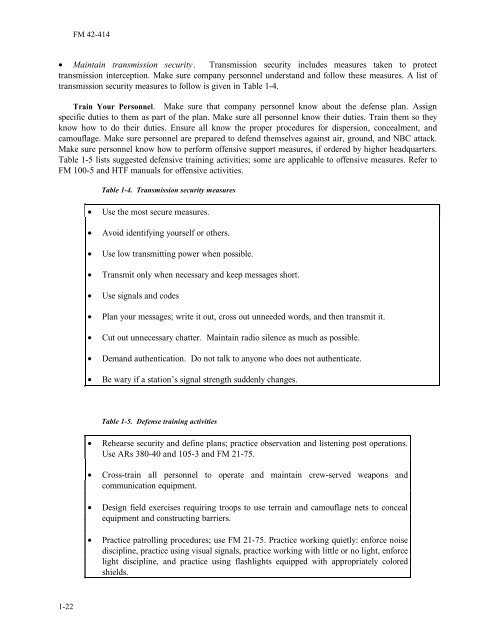Tactics, techniques, and procedures for - Army Electronic ...
Tactics, techniques, and procedures for - Army Electronic ...
Tactics, techniques, and procedures for - Army Electronic ...
You also want an ePaper? Increase the reach of your titles
YUMPU automatically turns print PDFs into web optimized ePapers that Google loves.
1-22<br />
FM 42-414<br />
• Maintain transmission security. Transmission security includes measures taken to protect<br />
transmission interception. Make sure company personnel underst<strong>and</strong> <strong>and</strong> follow these measures. A list of<br />
transmission security measures to follow is given in Table 1-4.<br />
Train Your Personnel. Make sure that company personnel know about the defense plan. Assign<br />
specific duties to them as part of the plan. Make sure all personnel know their duties. Train them so they<br />
know how to do their duties. Ensure all know the proper <strong>procedures</strong> <strong>for</strong> dispersion, concealment, <strong>and</strong><br />
camouflage. Make sure personnel are prepared to defend themselves against air, ground, <strong>and</strong> NBC attack.<br />
Make sure personnel know how to per<strong>for</strong>m offensive support measures, if ordered by higher headquarters.<br />
Table 1-5 lists suggested defensive training activities; some are applicable to offensive measures. Refer to<br />
FM 100-5 <strong>and</strong> HTF manuals <strong>for</strong> offensive activities.<br />
Table 1-4. Transmission security measures<br />
• Use the most secure measures.<br />
• Avoid identifying yourself or others.<br />
• Use low transmitting power when possible.<br />
• Transmit only when necessary <strong>and</strong> keep messages short.<br />
• Use signals <strong>and</strong> codes<br />
• Plan your messages; write it out, cross out unneeded words, <strong>and</strong> then transmit it.<br />
• Cut out unnecessary chatter. Maintain radio silence as much as possible.<br />
• Dem<strong>and</strong> authentication. Do not talk to anyone who does not authenticate.<br />
• Be wary if a station’s signal strength suddenly changes.<br />
Table 1-5. Defense training activities<br />
• Rehearse security <strong>and</strong> define plans; practice observation <strong>and</strong> listening post operations.<br />
Use ARs 380-40 <strong>and</strong> 105-3 <strong>and</strong> FM 21-75.<br />
• Cross-train all personnel to operate <strong>and</strong> maintain crew-served weapons <strong>and</strong><br />
communication equipment.<br />
• Design field exercises requiring troops to use terrain <strong>and</strong> camouflage nets to conceal<br />
equipment <strong>and</strong> constructing barriers.<br />
• Practice patrolling <strong>procedures</strong>; use FM 21-75. Practice working quietly: en<strong>for</strong>ce noise<br />
discipline, practice using visual signals, practice working with little or no light, en<strong>for</strong>ce<br />
light discipline, <strong>and</strong> practice using flashlights equipped with appropriately colored<br />
shields.

















